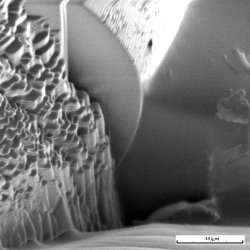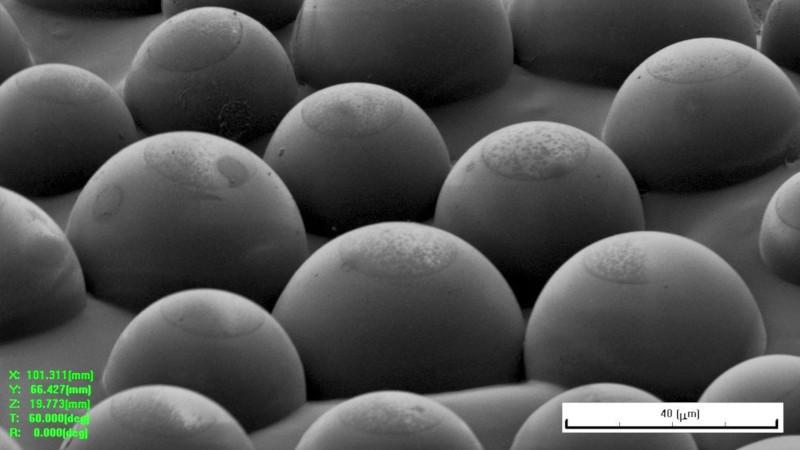Retroreflectors are interesting materials, so known for their nature of reflecting light back to its source. Examples include street signs, bicycle reflectors, and cat’s eyes, which so hauntingly pierce the night. They’re also used in the Tilt Five tabletop AR system, for holographic gaming. [Adam McCombs] got his hands on a Tilt Five gameboard, and threw it under the microscope to see how it works.

[Adam] isn’t mucking around, fielding a focused ion beam microscope for the investigation. This scans a beam of galium metal ions across a sample for imaging. With the added kinetic energy of an ion beam versus a more typical electron beam, the sample under the microscope can be ablated as well as imaged. This allows [Adam] to very finally chip away at the surface of the retroreflector to see how it’s made.
The analysis reveals that the retroreflecting spheres are glass, coated in metal. They’re stuck to a surface with an adhesive, which coats the bottom of the spheres, and acts as an etch mask. The metal coating is then removed from the sphere’s surface sticking out above the adhesive layer. This allows light to enter through the transparent part of the sphere, and then bounce off the metal coating back to the source, creating a sheet covered in retroreflectors.
[Adam] does a great job of describing both the microscopy and production techniques involved, before relating it to the fundamentals of the Tilt Five AR technology. It’s not the first time we’ve heard from [Adam] on the topic, and we’re sure it won’t be the last!
















Kudos for summing up the findings into in a single paragraph.
I didn’t need to, but I came here just to say this.
The link made me remember how much I hate Twitter. The only platform that is worse for a write-up is imgur.
IMHO, soundcloud or pornhub would be worse.
Hey, our podcast runs on
pornhubsoundcloud!Yeah, but it’s speak-up not a write-up :D
Is there a chance for a switch to the other alternative? Many people would then just need one account for all their computer use.
I think I found a typo, “…This allows [Adam] to very finally chip away…” I believe you meant to type ‘finely’.
Maybe it took many iterations?
B^)
They never fix typos here…
Do road signs go through an etch step? Wouldn’t the change in refractive index of the glass to glue interface make the spheres retroreflective anyway? You can buy plain glass spheres for making reflective surfaces by first painting the surface then dropping the glass beads on the still wet paint- the same way they paint the lines on roads… No etch is needed. Maybe the metal coating and etch makes it more efficient…
I am curious too about painted coating versus say a tape style reflector that’s sewn onto clothing or applied from a pre-coated/etched material. How does it work with painted surface coatings? Do they etch it after it’s painted?
It’s really the change in the refractive index. You can see that early in the morning. Dew drops reflect the sunlight and it looks like your shadow has a halo around its head. See also these pictures:
https://hjschlichting.wordpress.com/2017/05/07/wie-heilig-ist-der-heiligenschein/
The dew drops are like small glass spheres. If you take a picture, the halo is of course arond the camera.
I’m guessing it is about the efficiency. The road signs and stripes just need to stand out against the darkness with your headlights shining on them. For this AR setup, they have very low power projectors, and they want the image to be clear even in normal room lighting, even after going through polarizers and LCD shutters.
“Retroreflectors are interesting materials, so known for their nature of reflecting light back to its source. Examples include street signs, bicycle reflectors, and cat’s eyes, which so hauntingly pierce the night.”
BOTH kinds of cat’s eyes. ;-)
You mean tapioca is retroreflective?
B^)
I think that’s why they’re called cat’s eyes.